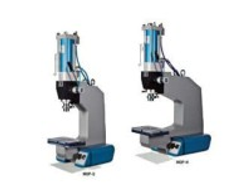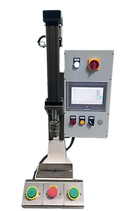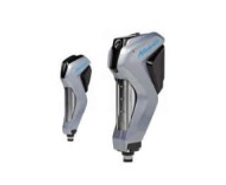- changdeliequip
- Sep 23, 2024
- 4 min read
Updated: Nov 15, 2024

In the world of manufacturing and production, achieving precision is often critical. The machine hand press is one piece of equipment that continues to play a vital role in various industries. Though it might seem simple compared to fully automated machinery, hand presses offer an unmatched level of control and accuracy. Hand presses machines are widely used across many industries for precision tasks, whether for metalworking, jewelry making, or electronics assembly.
1. Metalworking and Fabrication
Metalworking is one of the most common industries in which machine hand presses are used. When working with metal sheets, a hand press provides the force and precision needed to shape, bend, or punch holes in metal without the risk of damaging the material.
In particular, hand presses are helpful in metal stamping and punching processes. Whether creating automotive parts, small components for appliances, or custom metal pieces, hand presses allow operators to control the pressure and position of the material carefully. This makes it easier to achieve fine details and high-quality results.
2. Jewelry Making
When you think of jewelry making, you may not immediately picture a machine hand press, but this tool is invaluable for craftsmen working with metals and other materials. Whether shaping precious metals, embedding stones, or creating detailed engravings, machine hand presses allow jewelry makers to apply controlled pressure at specific points.
One of the main benefits for jewelers is the delicate touch that a hand press can provide. Automated machines may apply too much force, potentially ruining fragile pieces. A hand press allows jewelers to use the right amount of pressure for the desired effect.
Moreover, in an industry where uniqueness and craftsmanship are essential, hand presses give jewelry makers complete control over the design and production process, ensuring that every piece is of the highest quality.
3. Electronics Manufacturing
Machine hand presses are especially useful in assembling printed circuit boards (PCBs). Hand presses allow workers to fit delicate components such as capacitors, resistors, or connectors without damaging the intricate circuits.
The advantage of using a hand press in electronics manufacturing lies in the controlled pressure applied during the assembly process, which minimizes the risk of damaging sensitive components while ensuring secure connections.
4. Automotive Industry
The automotive industry relies on machine hand presses for various tasks, particularly in producing small parts and assemblies. Hand presses offer the force and accuracy required for custom parts, from creating metal brackets to assembling electronic components.
In addition, machine hand presses are frequently used in prototyping within the automotive sector. Before mass-producing car parts, manufacturers create prototypes to test designs.
Hand presses allow manufacturers to easily produce low-volume parts with great accuracy.
A hand press's versatility makes it a valuable tool in the automotive industry, where the demand for custom parts is high and quality must be maintained.
5. Leatherworking and Textile Industry
The world of leatherworking and textiles also depends on machine hand presses for various tasks. From stamping logos on leather goods to creating eyelets or rivets on fabrics, hand presses provide the accuracy needed for high-end, customized designs.
Similarly, hand presses fasten buttons, snaps, or grommets onto fabrics in the textile industry. These industries benefit from the fine control and precision hand presses offer, ensuring consistent, high-quality products.
6. Prototyping and Custom Manufacturing
While the previous sections focused on specific industries, it's also important to mention the role of machine hand presses in prototyping and custom manufacturing. Hand presses are often used to produce small-batch items or custom designs in various materials.
For instance, companies that create custom metal parts, tools, or fixtures often turn to machine hand presses for precise adjustments and modifications. A hand press's flexibility makes it easy to experiment with different designs before moving on to full-scale production.
Accuracy is paramount in prototyping, as small changes can significantly impact the final product. A machine hand press allows manufacturers to make those adjustments without investing in expensive tooling or complex machinery.
7. Plastic Component Manufacturing
Hand presses are also heavily relied upon in the plastic component industry for precision work. Machine hand presses can cut, emboss, and insert components into plastic products.
Whether used for medical devices, consumer electronics, or automotive parts, hand presses effectively ensure exact specifications in the assembly or production of plastic components.
8. Medical Device Manufacturing
Machine hand presses are commonly used in the production and assembly of small medical devices. They ensure that components are securely and accurately placed. Even the slightest misalignment can have serious consequences in this industry, so precise assembly is vital.
The ability to work in controlled environments with hand presses that do not generate heat or friction is especially important in ensuring the safe handling of delicate medical components.
9. Aerospace Industry
In the aerospace industry, where lightweight yet strong components are essential, hand presses are often employed to shape small metal components used in aircraft construction. Hand presses are valued for their precision in applications where automated machines may not provide the level of control needed for critical components.
From custom brackets to riveting in tight spaces, aerospace engineers rely on hand presses for intricate work that requires strength and precision.
10. Watchmaking and Horology
Finally, the watchmaking industry also extensively uses machine hand presses. Given that watches comprise many small components, horologists must be able to carefully assemble them precisely.
Hand presses allow watchmakers to fit tiny pieces like gears, screws, and pins into place without risking damage to the delicate materials involved. The fine control offered by hand presses is crucial in an industry where micrometer accuracy is often required.
Conclusion
Machine hand presses are essential in various industries, from metalworking and electronics manufacturing to jewelry making and aerospace. These industries rely on hand presses' precision, control, and flexibility, ensuring that critical components and assemblies are produced with high accuracy and efficiency.
Whether working with metals, plastics, textiles, or medical devices, the machine hand press remains a versatile and indispensable tool. Its ability to combine simplicity with precision work makes it an excellent choice for various applications.



